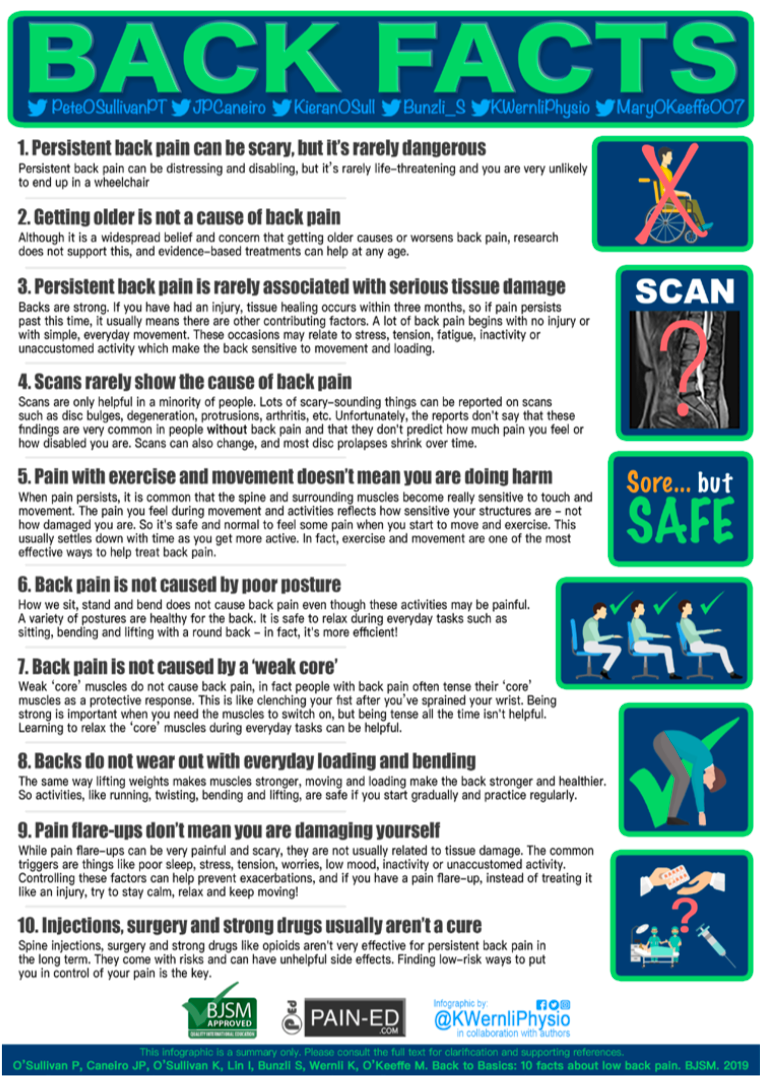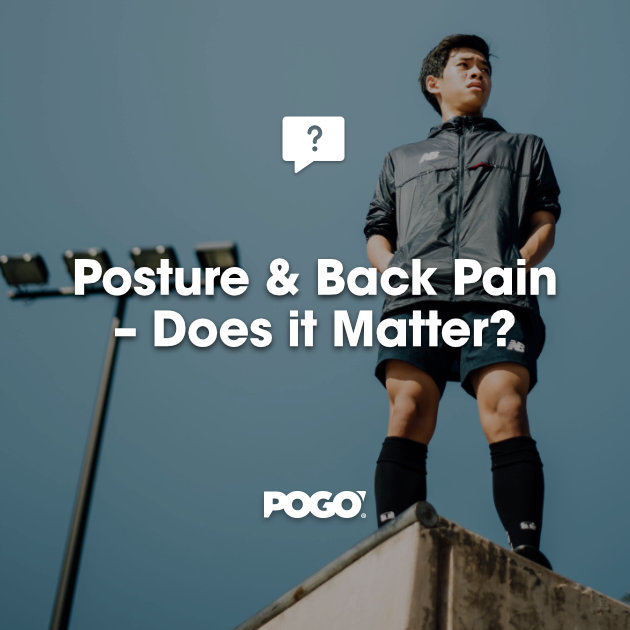10 facts every person should know about back pain

Low Back Pain is the most common presenting problem I see as a Physiotherapist, which makes sense as it is the leading cause of disability worldwide (1, 2). Unfortunately, Low Back Pain is often managed by outdated, ineffective and often costly treatments (1). These treatments are driven by outdated and unhelpful ideas and beliefs about our backs, what they can handle, and where pain comes from (1).
To help dispel some of these outdated ideas and beliefs, and restore people’s belief in their backs – some of the world’s leading Physiotherapy researchers put together this infographic below:
BACK FACTS

- Persistent back pain can be scary, but it’s rarely dangerous
Persistent back pain can be distressing and disabling, but it’s rarely life- threatening and you are very unlikely to end up in a wheelchair. - Getting older is not a cause of back pain
Although it is a widespread belief and concern that getting older causes or worsens back pain., research does not support this, and evidence-based treatments can help at any age. - Persistent back pain is rarely associated with serious tissue damage
Backs are strong. If you had an injury, tissue healing occurs within three months, so if pain persists past this time, it usually means there are other contributing factors. A lot of back pain begins with no injury or with simple, everyday movement. These occasions may relate to stress, tension, fatigue, inactivity or unaccustomed activity which make the back sensitive to movement and loading. - Scans rarely show the cause of back pain
Scans are only helpful in a minority of people. Lots of scary -sounding things can be reported on scans such as disc bulges, degeneration, protrusions, arthritis, etc. Unfortunately, the reports don;t say that these findings are very common in people without back pain and that they don’t predict how much pain you feel or how disabled you are. Scans can also change, and most disc prolapses shrink over time. - Pain with exercise and movement doesn’t mean you are doing harm
When pain persists, it is common that the spine and surrounding muscles become really sensitive to touch and movement. The pain you feel during movement and activities reflect how sensitive your structures are – not how damaged you are. So it’s safe and normal to feel some pain when you start to move and exercise. This usually settles down with time as you get more active. In fact, exercise and movement are one of the most effective ways to help treat back pain. - Back pain is not caused by poor posture
How we sit, stand and bend does not cause back pain even though these activities may be painful. A variety of postures are healthy for the back. It is safe to relax during everyday tasks such as sitting, bending and lifting with a round back – in fact, it’s more efficient! - Back pain is not caused by a ‘weak core’
Weak ‘core’ muscles do not cause back pain, in fact people with back pain often tense their ‘core’ muscles as a protective response. This is like clenching your fist after you’ve sprained your wrist. Being strong is important when you need the muscles to switch on, but being tense all the time isn’t helpful. Learning to relax the ‘core’ muscles during everyday tasks can be helpful. - Backs do not wear out with everyday loading and bending
The same way lifting weights makes muscles stronger, moving and loading make the back stronger and healthier. So the activities, like running, twisting, bending and lifting, are safe if you start gradually and practice regularly. - Pain flare-ups don’t mean you are damaging yourself
While the pain flare-ups can be very painful and scary, they are not usually related to tissue damage. The common triggers are things like poor sleep, stress, tension, worries, low mood, inactivity or unaccustomed activity. Controlling these factors can help prevent exacerbation’s, and if you have a pain flare-up, instead of treating it like an injury, try to stay calm, relax and keep moving up. - Injections, surgery and strong drugs usually aren’t a cure
Spine injections surgery and strong drugs like opioids aren’t very effective for persistent back pain in the long term. They come to risks and can have unhelpful side effects. Finding low-risk ways to put you in control of your pain is the key.
Whilst back pain, particularly in its acute form can be very painful and distressing, it’s important to remember that you are very unlikely to be damaged, and more importantly, you are SAFE TO MOVE.
Here at POGO Physio, we take pride in bringing the best evidenced based treatment for low back pain to our client’s – getting them back to doing what they love. If you want help overcoming your low back pain – book in with us online or by calling the practice.

Oliver Crossley (APAM)
POGO Physiotherapist
Book an appointment with Oliver here
Featured in the Top 50 Physical Therapy Blog
References:
- O’Sullivan, Peter B., J. P. Caneiro, Kieran O’Sullivan, Ivan Lin, Samantha Bunzli, Kevin Wernli, and Mary O’Keeffe. “Back to basics: 10 facts every person should know about back pain.” (2019).
- Hartvigsen, Jan, Mark J. Hancock, Alice Kongsted, Quinette Louw, Manuela L. Ferreira, Stéphane Genevay, Damian Hoy et al. “What low back pain is and why we need to pay attention.” The Lancet391, no. 10137 (2018): 2356-2367








